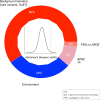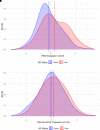Measuring heritable contributions to Alzheimer's disease: polygenic risk score analysis with twins
- PMID: 35169705
- PMCID: PMC8833403
- DOI: 10.1093/braincomms/fcab308
Measuring heritable contributions to Alzheimer's disease: polygenic risk score analysis with twins
Abstract
The heritability of Alzheimer's disease estimated from twin studies is greater than the heritability derived from genome-based studies, for reasons that remain unclear. We apply both approaches to the same twin sample, considering both Alzheimer's disease polygenic risk scores and heritability from twin models, to provide insight into the role of measured genetic variants and to quantify uncaptured genetic risk. A population-based heritability and polygenic association study of Alzheimer's disease was conducted between 1986 and 2016 and is the first study to incorporate polygenic risk scores into biometrical twin models of Alzheimer's disease. The sample included 1586 twins drawn from the Swedish Twin Registry which were nested within 1137 twin pairs (449 complete pairs and 688 incomplete pairs) with clinically based diagnoses and registry follow-up (M age = 85.28, SD = 7.02; 44% male; 431 cases and 1155 controls). We report contributions of polygenic risk scores at P < 1 × 10-5, considering a full polygenic risk score (PRS), PRS without the APOE region (PRS.no.APOE) and PRS.no.APOE plus directly measured APOE alleles. Biometric twin models estimated the contribution of environmental influences and measured (PRS) and unmeasured genes to Alzheimer's disease risk. The full PRS and PRS.no.APOE contributed 10.1 and 2.4% to Alzheimer's disease risk, respectively. When APOE ɛ4 alleles were added to the model with the PRS.no.APOE, the total contribution was 11.4% to Alzheimer's disease risk, where APOE ɛ4 explained 9.3% and PRS.no.APOE dropped from 2.4 to 2.1%. The total genetic contribution to Alzheimer's disease risk, measured and unmeasured, was 71% while environmental influences unique to each twin accounted for 29% of the risk. The APOE region accounts for much of the measurable genetic contribution to Alzheimer's disease, with a smaller contribution from other measured polygenic influences. Importantly, substantial background genetic influences remain to be understood.
Keywords: APOE; Alzheimer’s disease; heritability; polygenic risk scores (PRSs); twins.
© The Author(s) 2022. Published by Oxford University Press on behalf of the Guarantors of Brain.
Figures




References
Grants and funding
- MR/L501542/1/MRC_/Medical Research Council/United Kingdom
- G0701075/MRC_/Medical Research Council/United Kingdom
- G1001253/MRC_/Medical Research Council/United Kingdom
- G-1307/PUK_/Parkinson's UK/United Kingdom
- MR/P005748/1/MRC_/Medical Research Council/United Kingdom
- R01 AG060470/AG/NIA NIH HHS/United States
- MR/J004758/1/MRC_/Medical Research Council/United Kingdom
- G0901254/MRC_/Medical Research Council/United Kingdom
- MR/T033371/1/MRC_/Medical Research Council/United Kingdom
- MR/K01417X/1/MRC_/Medical Research Council/United Kingdom
- G-0907/PUK_/Parkinson's UK/United Kingdom
- MR/T04604X/1/MRC_/Medical Research Council/United Kingdom
- G0801418/MRC_/Medical Research Council/United Kingdom
- MR/L023784/2/MRC_/Medical Research Council/United Kingdom
- RF1 AG058068/AG/NIA NIH HHS/United States
- MR/L010305/1/MRC_/Medical Research Council/United Kingdom
LinkOut - more resources
Full Text Sources
Miscellaneous
